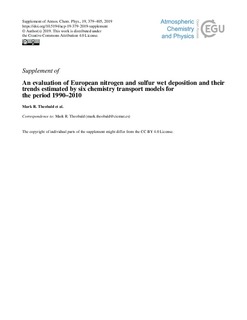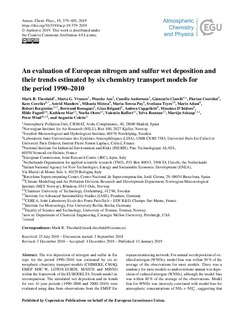| dc.description.abstract | The wet deposition of nitrogen and sulfur in Europe for the period 1990–2010 was estimated by six atmospheric chemistry transport models (CHIMERE, CMAQ, EMEP MSC-W, LOTOS-EUROS, MATCH and MINNI) within the framework of the EURODELTA-Trends model intercomparison. The simulated wet deposition and its trends for two 11-year periods (1990–2000 and 2000–2010) were evaluated using data from observations from the EMEP European monitoring network. For annual wet deposition of oxidised nitrogen (WNOx), model bias was within 30 % of the average of the observations for most models. There was a tendency for most models to underestimate annual wet deposition of reduced nitrogen (WNHx), although the model bias was within 40 % of the average of the observations. Model bias for WNHx was inversely correlated with model bias for atmospheric concentrations of NH3+NH+4 , suggesting that an underestimation of wet deposition partially contributed to an overestimation of atmospheric concentrations. Model bias was also within about 40 % of the average of the observations for the annual wet deposition of sulfur (WSOx) for most models. Decreasing trends in WNOx were observed at most sites for both 11-year periods, with larger trends, on average, for the second period. The models also estimated predominantly decreasing trends at the monitoring sites and all but one of the models estimated larger trends, on average, for the second period. Decreasing trends were also observed at most sites for WNHx, although larger trends, on average, were observed for the first period. This pattern was not reproduced by the models, which estimated smaller decreasing trends, on average, than those observed or even small increasing trends. The largest observed trends were for WSOx, with decreasing trends at more than 80 % of the sites. On average, the observed trends were larger for the first period. All models were able to reproduce this pattern, although some models underestimated the trends (by up to a factor of 4) and others overestimated them (by up to 40 %), on average. These biases in modelled trends were directly related to the tendency of the models to under- or overestimate annual wet deposition and were smaller for the relative trends (expressed as % yr−1 relative to the deposition at the start of the period). The fact that model biases were fairly constant throughout the time series makes it possible to improve the predictions of wet deposition for future scenarios by adjusting the model estimates using a bias correction calculated from past observations. An analysis of the contributions of various factors to the modelled trends suggests that the predominantly decreasing trends in wet deposition are mostly due to reductions in emissions of the precursors NOx, NH3 and SOx. However, changes in meteorology (e.g. precipitation) and other (non-linear) interactions partially offset the decreasing trends due to emission reductions during the first period but not the second. This suggests that the emission reduction measures had a relatively larger effect on wet deposition during the second period, at least for the sites with observations. | nb_NO |


